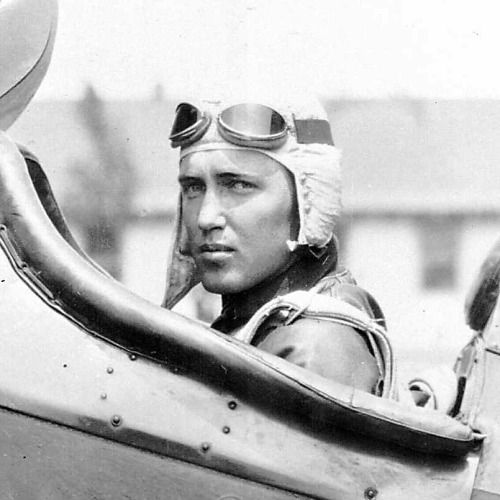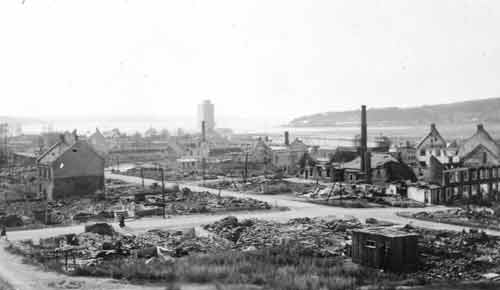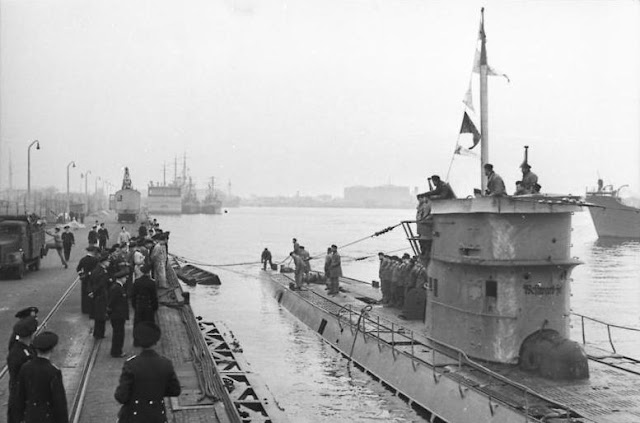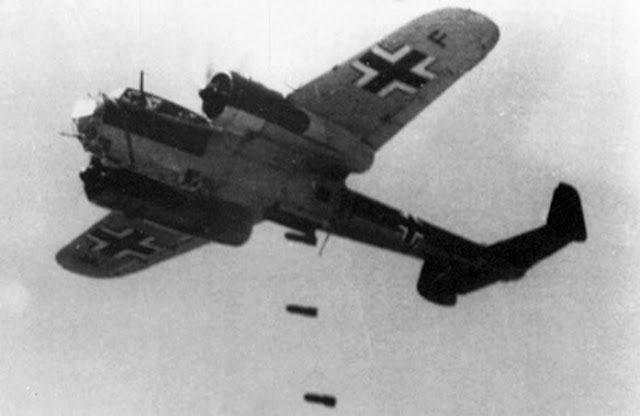Tuesday 30 April 1940
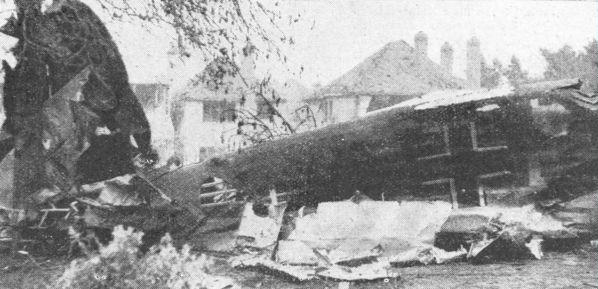 |
| The "Clacton Heinkel" which crashes on 30 April 1940. |
General Otto Ruge issues a somewhat different statement:
Allied forces are withdrawing from Romsdal and presumably Namsos. The situation has thus been changed. A military collapse is to be expected in Gudbrandsdalen, Romsdal and Trondelag. The Government and Army High Command are transferring to Northern Norway.Norway Army Operations: The British at Andalsnes begin evacuating during the night. The British 15th Brigade at Dombås is given the order to retire after holding there all day against German attacks. The 15th leaves by train for Andalsnes, where they will be evacuated. At 17:00, cruisers HMS Manchester & Birmingham and destroyers HMS Inglefield, Diana and Delight, all under Vice-Admiral Layton, all depart Scapa Flow for this mission.
General de Wiart's troops at Namsos are also waiting to be evacuated by the destroyer force that is en route from Scapa Flow.
The Germans of the 196th Infantry Division occupy Dombås and make contact with German troops of the 359th Infantry Regiment south of Trondheim. They are on foot because they have had to leave their vehicles behind the bridges that the British demolished.
The Germans coming west from the Osterdal link up with their comrades at Dragset.
Narvik is the new focus of Allied operations in Norway. Norwegian 6th Infantry Brigade, 7th Infantry Brigade, and French 27th Demi-Brigade de Chasseurs are slowly advancing toward Narvik from the north.
 |
| The devastation caused by the Clacton-on-Sea Heinkel. |
The RAF bombs Stavanger and Oslo-Fornebu airfields overnight, and they also attack Aalborg airfield in Denmark. The RAF wants to minimize disruptions of the evacuations.
Two British aircraft carriers, HMS Ark Royal and Glorious, provide some air cover. The Luftwaffe goes out to attack them, and they are forced to retreat further off the coast.
Anti-submarine trawler HMS Warwickshire is sunk by the Luftwaffe off Trondheim.
Battle of the Atlantic: Monthly April 1940 shipping losses:
- 58 Allied Ships
- 158,218 tons
- 5 U-boats sunk
Royal Navy minesweeper HMS Dunoon hits a mine and sinks off Great Yarmouth near Smith's Knoll. There are 27 lives lost.
Kriegsmarine torpedo boat Leopard is involved in a collision in the Skagerrak and sinks.
French destroyer Maille Breze has two of its own torpedoes explode and destroy it in the Clyde. There are 25 deaths, 48 wounded.
Convoy OB 139 departs from Liverpool, Convoy SL 30 departs from Freetown, and Convoy HX 39 departs from Halifax.
Minesweeping trawler HMS Fir (J. W. H. Whitelaw) is commissioned.
US Military: The Norwegian tanker Willy catches fire in the Cooper River at Charleston, South Carolina. If allowed to burn, it could have destroyed the ship and the Charleston pier. The Commandant of the Sixth Naval District organizes a team that extinguishes the fire.
US/Italian Relations: President Roosevelt sends Mussolini a personal telegram that begins, "My dear Signor Mussolini."
 |
| High wind damage in the first block of Elliott Street in Chaffee, Mo., on the day after a tornado struck about 5:35 p.m. on April 30, 1940. |
April 1940
April 1, 1940: Weserubung is a GoApril 2, 1940: British Subs On Alert
April 3, 1940: Churchill Consolidates Power
April 4, 1940: Missed the Bus
April 5, 1940: Mig-1 First Flight
April 6, 1940: Troops Sailing to Norway
April 7, 1940: Fleets At Sea
April 8, 1940: HMS Glowworm and Admiral Hipper
April 9, 1940: Invasion of Norway
April 10, 1940: First Battle of Narvik
April 11, 1940: Britain Takes the Faroes
April 12, 1940: Germans Consolidate in Norway
April 13, 1940: 2d Battle of Narvik
April 14, 1940: Battle of Dombås
April 15, 1940: British in Norway
April 16, 1940: Germans Cut Norway in Half
April 17, 1940: Trondheim the Target
April 18, 1940: Norway Declares War
April 19, 1940: Dombås Battle Ends
April 20, 1940: Germans Advancing in Norway
April 21, 1940: First US Military Casualty
April 22, 1940: First British Military Contact with Germans
April 23, 1940: British Retreating in Norway
April 24, 1940: British Bombard Narvik
April 25, 1940: Norwegian Air Battles
April 26, 1940: Norwegian Gold
April 27, 1940: Allies to Evacuate Norway
April 28, 1940: Prepared Piano
April 29, 1940: British at Bodo
April 30, 1940: Clacton-on-Sea Heinkel
May 1940
May 1, 1940: British Leave ÅndalsnesMay 2, 1940: British Depart Namsos
May 3, 1940: Many Norwegians Surrendering
May 4, 1940: Bader Returns
May 5, 1940: HMS Seal Survives
May 6, 1940: Allies Focus on Narvik
May 7, 1940: In The Name of God, Go!
May 8, 1940: Exit Chamberlain
May 9, 1940: Enter Churchill
May 10, 1940: Fall Gelb
May 11, 1940: Eben Emael Surrenders
May 12, 1940: Germans at Sedan
May 13, 1940: Rommel at Work
May 14, 1940: German Breakout in France
May 15, 1940: Holland Surrenders
May 16, 1940: Dash to the Channel
May 17, 1940: Germans Take Brussels
May 18, 1940: Germans Take Antwerp
May 19, 1940: Failed French Counterattack
May 20, 1940: Panzers on the Coast
May 21, 1940: Battle of Arras
May 22, 1940: Attacking Channel Ports
May 23, 1940: British Evacuate Boulogne
May 24, 1940: Hitler's Stop Order
May 25, 1940: Belgian Defenses Creaking
May 26, 1940: Operation Dynamo
May 27, 1940: King Leopold Surrenders
May 28, 1940: The Allies Take Narvik
May 29, 1940: Lille Falls
May 30, 1940: Operation Fish
May 31, 1940: Peak Day for Dynamo
2019









